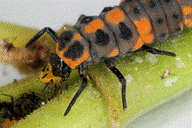Papers in the Biological Sciences

Brigitte Tenhumberg Papers
Document Type
Article
Date of this Version
2014
Citation
Published in Ecological Entomology 39 (2014), pp. 263–266; doi 10.1111/een.12080
Abstract
1. Pea aphids (Acyrthosiphon pisum Harris; Hemiptera: Aphididae) exhibit transgenerational wing polyphenism, in which unwinged females produce genetically identical winged offspring in response to environmental cues such as overcrowding and predation risk that indicate poor habitat quality.
2. Laboratory experiments were carried out to explore the intensity of the wing polyphenic response of pea aphids exposed to cues from ladybird predators and crowding, and their response was compared with pea aphids that were not exposed to any cues (control).
3. The study used cues from two different ladybird species—Coccinella septempunctata L. (Coleoptera: Coccinellidae) and Hippodamia convergens Guérin-Méneville (Coleoptera: Coccinellidae)—to investigate whether the wing polyphenic response of pea aphids to predator cues can be generalized.
4. The intensity of the wing polyphenic response of pea aphids to crowding was found to be much stronger than their response to predator cues. There was no response to H. convergens cues and the response to C. septempunctata cues was mixed.
Includes 2 supplementary tables.


Comments
Copyright © 2013 Royal Entomological Society. Used by permission.